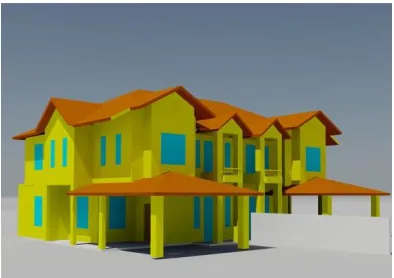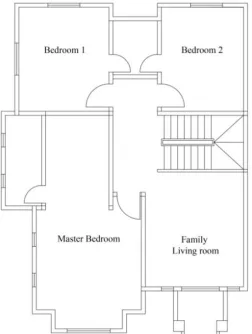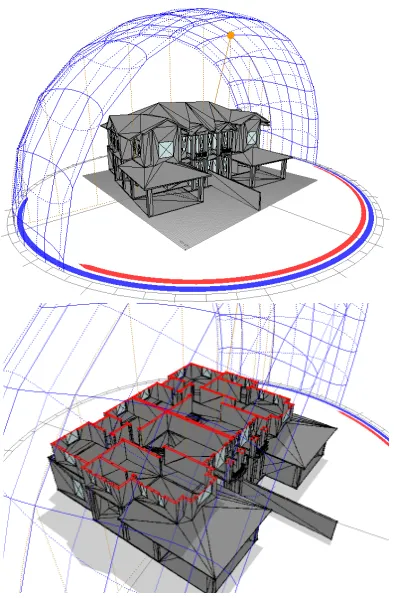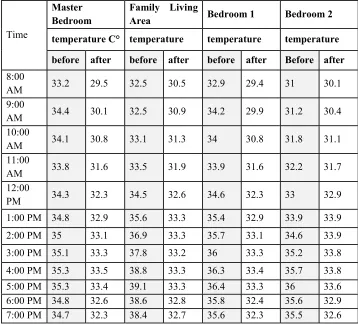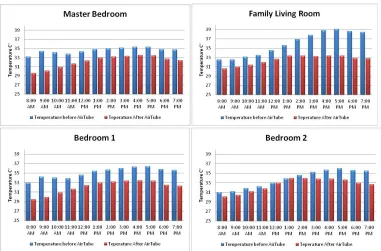THE IMPROVEMENT OF THE VENTILATION SYSTEM IN THE EXISTING TERRACED HOUSES IN MALAYSIA
Yasser Arab1 and Ahmad Sanusi Hassan2
School of Housing Building and Planning, Universiti Sains Malaysia 11800, Penang, Malaysia
1: yasserarab2005@yahoo.com, 2: sanusi@usm.my
ABSTRACT
This study aims to find a sustainable solution in order to reduce the indoor temperature in hot and humid climate such as Malaysia. The focus of this study is to create a new device (Air Tube) which is considered to be a remedial device for the indoor spaces, and can be installed for the existed houses. The method of this study is to design the Air Tube device and install is in the rooms of second floor in semi-detached and terrace house in order to reduce the temperature few degrees. The study will depend on taking manual measurements in the site and making simulation using computer software Ecotect on 14th of February (which considered to be the hottest day in the year) and trying to find the best solution to reduce the temperature in such hot and humid weather, the case study is a semi-detach house with post-modern architectural style, which is located in Sungai Petani, Kedah, Malaysia. The research finds that AirTubeis a good solution for the existed houses to decrease the temperature and reach the thermal comfortable atmosphere.
Key Words: AirTube, Ecotect, semi-Detached Houses
1. INTRODUCTION
One of the most important issues which are facing architects nowadays is to reduce the energy consumption in building. The residency buildings are tend to be a very wide aspect of buildings where many studies and researches have taken place in term of daylighting, shading, energy generating and ventilation system seeking clean and sustainable solutions for energy consumption (Ihm, et al. 2009, Bodart and Herde 2002, J. Hirunlabh, et al. 1999), all previous studies focused on creating new strategies and techniques in order to have alternative energy resources for the new buildings whereas this study focuses on houses which already existed. The study aims to create a new device which is considered to be a
DOI: 10.1051/
C
Owned by the authors, published by EDP Sciences, 201
/2 01 shsconf
0 00 (201 )
SHS Web of Conferences
architecture in some of the Arab countries like Syria, Iraq and Egypt and Iran (El-Shorbagy, 2010, El-Shorbagy, 2010 and Montazeri, Montazeri, Azizian, & Mostafavi, 2010).
And some other studies in the tropical countries like Malaysia and Thailand which have different circumstances in terms of the wind, temperature and humid, these studies depended on the stack effect. But all those studies where trying to come out with a good solution for natural ventilation systems for the new buildings such as a Metallic Solar Wall (Hirunlabh, Kongduang, Namprakai, & Khedari, 1999) and a Solar Chimney (BANSAL, MATHUR, & BHANDARI*, 1993).
3. CASE STUDY
Figure 1. Case study, Semi-detach house (photo and perspective)
Figure 2. Case study (Left: Elevation, Middle: Ground floor plan and Right: First floor plan)
4. METHODOLOGY
[image:3.482.53.440.243.441.2]Figure 3. Thermal analysis selected areas.
5. MEASUREMENT SCALE
The scale of the measurement can be identified by the temperature level, humidity and wind speed, which can show the performance of cross air ventilation and stack effect. The measurable scale for temperature is in Celsius, humidity in percentage and wind speed in meter per second. The device used to record the scale of measurements is anemometer. The measurable scale of the temperature refers to The Canadian index (2009), called Humidex. This index categories human comfort level which is to ‘reflect perceived temperature’ using
combination of temperature and humidity. There is so far no study conducted to give a specific measurable scale of the temperature in the tropical region. The measurable scale also refers to the study of Abdul Rahman. The reason is that perception by the people who live in tropical regions are different from those in temperate and cold regions (Lipinga and Hien 2007, Singha, Mahapatrab and Atreya 2010). Abdul Rahman (1995) in his study found that the most comfortable indoor temperature in Malaysia (tropical region) ranges from 25.5o C to 28oC compared to the general recommendation by World Health Organization (Organization 1990), from 18oC to 28oC. The reason is hot and humid temperature throughout a year gives
an impact to the people’s perception to the thermal comfort at higher temperature in contrast
[image:4.482.177.303.88.255.2]to those in temperate region. Scale No. 2 (Table 1) is considered as the best level of performance of the temperature factor. The measurable scale is as follows:
Table 1. The scale of measurement for temperature Scale Description Celsius
0 Cold Less than 16
2 Comfort 25.5 - 28
3 Warm 28 - 32
4 Hot 32 - 40
[image:5.482.142.339.190.489.2]5 Extremely Hot Above 40
Figure 4. Sun path during the year and day (left) semi-detached house perspective, (right) perspective section.
6. RESULTS OF ANALYSIS
After getting the simulation’s results, a comparative study creates in order to compare
performance improved to reach 3 degrees less than the temperature before installing the AirTube.
Table 2. Temperatures in the selected room before and after installing AirTubes.
Time
Master Bedroom
Family Living
Area Bedroom 1 Bedroom 2
temperature C° temperature temperature temperature before after before after before after Before after 8:00
AM 33.2 29.5 32.5 30.5 32.9 29.4 31 30.1 9:00
AM 34.4 30.1 32.5 30.9 34.2 29.9 31.2 30.4 10:00
AM 34.1 30.8 33.1 31.3 34 30.8 31.8 31.1 11:00
AM 33.8 31.6 33.5 31.9 33.9 31.6 32.2 31.7 12:00
Figure 5, Chart lines of selected room’s the temperature before and after adding the Air Tube.
7. CONCLUSION
The research finds that Air Tube device manages to adjust the atmosphere and decline
air temperature inside the last storey’s room in the semi-detached houses. Figure 5 shows that
there are differences in the effect of Air Tube in the rooms based on the area, number of windows and orientation, and that will play a role in specifying the number and size of Air Tube which has to be installed in the room. This study concludes that the Air Tube is efficient to decrease the temperature of the semi-detached house’s second storey for few degrees and it is a good sustainable solution for the exited houses in order to adjust the atmosphere to fit the thermal comfort standard in the tropical climate.
REFERENCES
BANSAL, N. K., RAJESH MATHUR, and M. S. BHANDARI*. "Solar Chimney for Enhanced Stack Ventilation ." Building and Environment , 1993: 373-377.
Bodart, M, and A De Herde. "Global energy savings in offices buildings by the use of daylighting." Energy and Buildings, 2002: Vol 34 (5) P 421-429.
Lipinga, Wang, and Wong Nyuk Hien. "Applying Natural Ventilation for Thermal Comfort in Residential Buildings in Singapore." Architectural Science Review, 2007: Vol 50 (3), P 224-233.
Montazeri, H., F. Montazeri, R. Azizian, and S. Mostafavi. "Two-sided wind catcher performance evaluation using experimental, numerical and analytical modeling."
Renewable Energy, 2010: 1424-1435.
Organization, Worl Health. ndoor Environment: Health Aspects of Air Quality, Thermal Environment, Light and Noise. London : World Health Organisation, 1990.
Rahman, Abdul Malik Abdul. "Housing Design in relation to Environmental Comfort."
Building Research & Information, 1995: Vol 23 (1) P 49-54.
Singha, Manoj Kumar, Sadhan Mahapatrab, and S.K. Atreya. "Thermal performance study and evaluation of comfort temperatures in vernacular buildings of North-East India."
Building and Environment, 2010: Vol 45 (2) P 320–329.
statistics, Department of. Population Distribution and Basic Demographic Characteristics .
Kuala Lumpur : Banci Gensus, 2010.
The Canadian Index. Temperature/Humidity Comfort Level. October 10, 2009.
